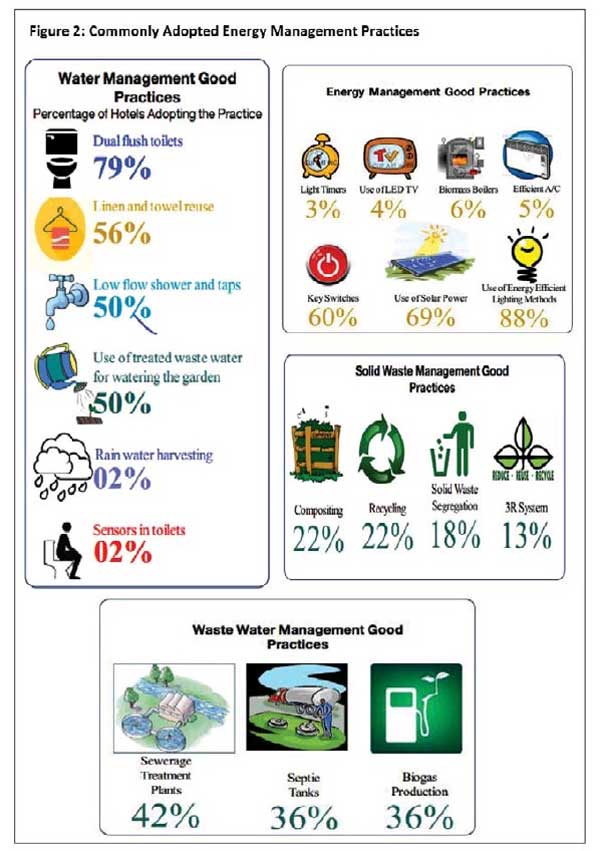
By Kanchana Wickramasinghe
With the tourism sector in Sri Lanka recording remarkable growth in the recent past, it is imperative to ensure such growth is environmentally sustainable. In this regard, the accommodation should receive foremost attention given its expansions both in terms of investments in new hotels and refurbishments of existing hotels in the country.
Around 37 registered hotels have been added during t he period between 2009 and 2013, according to the statistics of the Sri Lanka Tourism Development Authority. Currently, adoption of good environmental management practices is taking place in the hotel industry but on a voluntary basis. It is important to understand what motivates hotels to adopt good environmental management practices and identify barriers to their adoption so that such activities could be encouraged.
A recent IPS study looked at the adoption of good energy, water and waste management practices in hotels in Sri Lanka. The findings of the study were based on econometric analysis using data gathered through a comprehensive survey of registered hotels in the Western Province, which has the highest number of hotels at provincial level.
On average, the study found that 7.81 good environment practices are currently in place. Of the different good environmental management practices, those relating to energy were the most commonly adopted followed by water, solid waste and waste water practices (Figure1).
It was interesting yet not surprising to note that comparatively large hotels (with more than 50 rooms) perform better than their smaller counterparts. For example, the total number of good environmental management practices (energy + water + waste) is around 9.3 in large hotels compared to the figure of 5.6 in small hotels.Energy, water, waste water and solid management practices
Most commonly adopted energy management practices (Figure 2) include: use of energy-efficient lighting methods (88 percent), use of solar power (69 percent) and key switches (60 percent). However, the contribution of each practice towards energy saving depends on the intensity of adoption. For instance, possible savings due to energy-efficient lighting is dependent on the proportion of energy-efficient bulbs used in a hotel.
The study also found that dual flush toilets (79 percent) and linen and towel reuse (56 percent) are most common water management practices among the hotels that participated in the survey. Some of the water management practices need the participation of the customers to save the amount of water consumption. For instance, correct handling of dual flush toilets, linen and towel reuse, etc., require customers’ involvement. However, other water management practices, such as low flow showers and taps, reuse of treated waste water and sensors in toilets directly lead to water saving, irrespective of customer involvement.
In terms of solid waste management, over 65 percent of the hotels’ waste is collected by the municipal council. Good solid waste management practices include composting (22 percent), recycling (22 percent) and solid waste segregation (18 percent). In addition, the study looked at waste water management and found that 42 percent of the hotels have sewerage treatment plants.Determinants in adoption of good environmental management practices
The study assessed factors which determine the number of good practices in energy, water and waste management adopted in hotels. Accordingly, the size of the hotel, percentage of guests for leisure purposes, number of employees per room and the location of the hotels determine the adoption of good environmental management practices. Also, hotels that have undergone capacity building, training and were provided awareness support, demonstrated better environment management practices.
Barriers to adoption
An important finding of the study is that the barriers to adopting good environmental management practices are not the same among small and large hotels. The most commonly observed barrier for the large hotel category is the perception that cost of adopting good practices exceeds the benefits. Under the small hotel category, the most observed barrier was that environmental management is not a top priority. Lack of financial resources and constraints due to the structure of hotels and limitations in space were also significant barriers.Policy attention for an environmentally sustainable hotel industry
Policy-wise it is i mportant that more attention is given to small hotels to improve their environmental management activities, as they are lagging behind. Space and structural constraints are common barriers for adopting good environmental management practices. This indicates that environmental management should be considered at the initial stage of designing hotels or when considering refurbishments.
These findings call for greater awareness, training and capacity building support t o i mprove environmental management practices in the hotel industry and thereby promote sustainable tourism in Sri Lanka.


